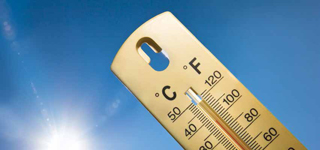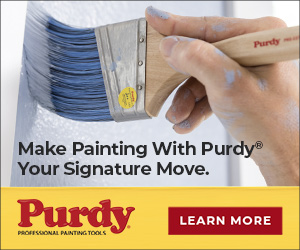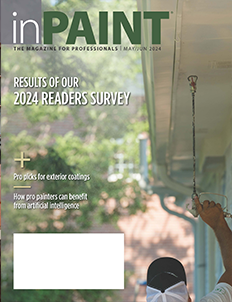It’s HOT Out There!
 In the middle of the summer, the Sonoran desert’s evening temperatures can still hover around 100º Fahrenheit. It’s a dry heat with an oven effect that’s uncomfortable for human beings and paint formulas alike.
In the middle of the summer, the Sonoran desert’s evening temperatures can still hover around 100º Fahrenheit. It’s a dry heat with an oven effect that’s uncomfortable for human beings and paint formulas alike.
Most paint manufacturers will recommend temperatures not exceed 90º for good adhesion. Jeff Pinosky, owner of Classic Shades Painting, Water Damage & Restoration Services, located in Phoenix, Arizona, knows plenty about the pitfalls that come with summer painting. In order to deliver quality when Mother Nature won’t cooperate for a solid stretch of four or more months, he first employs some common sense.
“I’ll start at 4:30 in the morning and wrap up by 11:00,” he says, while adding that he uses the rest of his day for prep work or to bid on other jobs.
Beyond the early starts, there are plenty of other factors to consider when painting in the heat. A few experts, including Pinosky, offered some ideas on how to avoid summer paint failures and keep customers happy.
SPEED DRYING
The ideal temperature range for paint application is roughly between 45º and 90º Fahrenheit. But some experts are more conservative with their guidance.
“Typically, we define anything over 85º as a temperature that can really create havoc with the paint,” said Debbie Zimmer, an expert with the Paint Quality Institute.
In warmer temperatures, the water in latex paint dries very quickly. This can pose problems with how paint lays down off the brush or roller, added Zimmer. In many cases, the top layer of paint dries but the layer underneath doesn’t. This can cause uneven drying and compromise the rheology of a paint. Often times, Pros will spend the extra money for a higher-quality paint that flows off the roller well and covers evenly, only to compromise all those qualities by painting in high temperatures.
“You want it to dry evenly so that water comes off in a very methodical fashion … so that the paint polymers, binders and pigment particles all fuse together as they should,” added Zimmer. “If this doesn’t happen, the paint will not properly adhere to the surface and you could have paint failure.”
Pinosky has also experimented with latex satin paints as a substitute for flat paint on exteriors in the harsh desert heat.
“I find flats don’t hold up well. The satin does turn flat over time, but I’ve had really good feedback on that,” he said.
SHADE, SURFACES
Following the shade is key for summertime painting. But if temperatures rise above 90º, even shaded areas can pose problems. Paint can ‘skin’ in the can or compressor, and paint that dries too quickly after application can be compromised.
Damon Caryofilles of Damon’s Painting in upstate New York also worked in the valleys of Northern California, where temperatures can reach 100º in the summer. He was constantly watching the weather and adjusting his schedule between prepping and actual painting.
“Some days, I would just schedule an exterior pressure wash,” he said. “If it’s going to be a 110º-day, there’s no way I’m going to apply material to a house.”
Substrate temperatures must also be taken into consideration. Even on cooler days, surfaces exposed to the sun for an extended period of time can still be hot. And after the sun goes down on a warm day, it’s important to check the surface temperature either with a pocket tool or at least by hand before applying paint or primer, Zimmer said.
“Especially homes with metal front doors or black doors; those areas can heat up quickly and remain hot for a long time,” she added.
BEYOND THE HEAT
Beyond surface and ambient temperatures, wind can also accelerate drying in addition to potentially blowing contaminants on wet or prepped surfaces.
But humidity can be a greater concern. Not only will it encourage mold and algae growth, humidity affects paint’s ability to fill in the peaks and valleys of a surface, added Zimmer.
Humidity can also extend dry time with a greater potential for sagging, as the top layer may dry long before the underneath layer. Oil-based paints take an even longer time to dry on humid days. Zimmer advises not to paint in humidity above 85%. Ideal humidity is probably in the 50% range.
Also, early start times make sense in dry climates like deserts, however starting too early when there is dew or moisture on the surface can compromise quality as well.
Caryofilles also says surface prep is very important in the hot months. But the heat can undo a lot of hard work too. “You can do the best surface prep in the world, but if you’re applying that paint and it’s not forming a tight film across the substrate, you certainly may run into issues down the road,” Zimmer added.
Some jobs may not show signs of failure right away, but when the cold season starts and chemicals and surfaces contract, that may be the first sign of poor warm-weather work.
“If you have a compromised film, it just might not be strong enough to handle the freeze,” Zimmer added.
Working in California, Caryofilles also saw his share of stucco homes. For stucco in the heat, he recommends backrolling. Many Pros like to use a compressor for stucco surfaces. Caryofilles likes to use a roller instead. He emphasizes that backrolling helps to fill in open pores, crevices and shadow lines. He even likes to get up close to the surface and look for bubbles in the form of black dots. Bubbles indicate where the paint is not penetrating well into the valleys of the surface.
“I like to make sure the surface is completely tight. That means there are no open pores; no black dots telling me paint is not getting in there,” he said.
ADDITIVES
One area where paint Pros are split is in the use of ‘latex extenders,’ like Floetrol, and other additives. Floetrol and other chemicals help to avoid skinning and early drying, and allow for easier application in the heat. Some manufacturers even recommend adding water; 4–6 ounces per gallon to maintain workability.
But many Pros are concerned about compromising paint quality with extenders.
Zimmer is particularly apprehensive about using any additives, even mildewcides and algaecides, in brush and roll situations. However, it’s not uncommon for Pros to use a small amount of water to keep a spray gun from clogging. That’s a more acceptable practice, according to Zimmer.
“Scientists have spent a lot of time developing the technology in a can of paint,” the expert added. “There’s a lot of testing and evaluating to get the best balance of properties. When you pour something into that can of paint, what’s changing? I wouldn’t start playing with that.”
But there are plenty of Pros who don’t mind using the extenders. Caryofilles is one of them; but Pinosky shies away from them, largely for concerns about compromising colors. Some experts say if a paint keeps skinning or drying and a lot of extender is needed, that could mean a problem with paint quality. A paint is formulated to be used as it is in the can, most professionals agree, and if an additive must be added in order for the paint to effectively cover a space, a higher-quality paint is probably the solution, not more Floetrol.
EQUIPMENT, SAFETY
Heat can also threaten the life of your compressor, said Pinosky. If the paint inside the compressor skins, which it primarily does when paint levels get low, it can gum up the compressor’s feed line. For machines that don’t have electronic shutoffs when the paint gets too low, workers need to monitor paint levels and add paint before they get too low. Otherwise, the machine will run sluggishly or cycle too much, said Pinosky.
He also keeps a close eye on his paintbrushes on hot days. He notices the back bristles of a brush will gum up quicker. He uses a wire brush to keep them clean and flexible. Paint cans should also stay covered to avoid skinning.
Pinosky, who ran several crews and handled safety meetings for a large San Francisco painting contractor prior to starting his own business, says it’s easy to overlook crew safety in hot weather. In the harsh desert heat, the entrepreneur is as much a team water boy as he is a paint Pro.
“You can use up a lot of energy and you don’t even have to be in the sun. You have to be well-watered,” he said. “Productivity will go down. Pants will sag with sweat and you can become irritable. … You really have to watch your guys. You don’t want anyone falling off a ladder.”
PUSHY CUSTOMERS
Sometimes the customer wants the job done quickly, regardless of the weather. Caryofilles says it’s important to explain that putting off work for a day or two due to excessive heat is a move in the interest of quality.
“Communication is key. The customer usually respects the fact that you want to do a good job,” he added. Some customers who are in a time crunch may be more assertive with a paint Pro. So, a contractor may feel like getting the job done is more important than doing it right.
“I know so many people skirt around the issue and say, ‘I don’t want to take a day off. I’ve gotta’ get it done today.’ But you should really plan for a cooler day,” Zimmer added.




